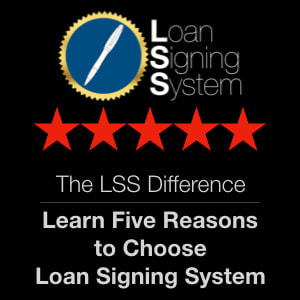|
By Mark Wills - Course Instructor of the Loan Signing System, Forbes Real Estate Council Member, and Best-Selling Author
Making Money as a Notary Public Loan Signing Agent is One of The Best-Kept Secrets in the Real Estate Industry.
Why?
Because you can make GREAT money working for yourself on your own schedule, with absolutely no experience, college degree, or special qualifications required. That's right — Small business owner. Big bucks. And thousands of people across the nation are doing it right now, using nothing more than an active notary commission. As in any career, though, understand that there is some learning involved... The More You Learn, the More You Earn
Like I teach in my five star-rated Loan Signing System course... being a great notary loan signing agent means being an educated notary loan signing agent.
Knowing the documents in a borrower's set of loan paperwork is a key component in ensuring a fast signing appointment — and more importantly, it's one of the primary reasons why loan signing agents get paid so much money. And the first step in understanding the documents is to learn basic real estate and mortgage loan terminology. The following are some of the most common terms found in mortgage loan documents. I've also included escrow verbiage, which is available as a bonus in my Loan Signing System course for notary loan signing agents, found at the bottom of this page. Here Are the Top 28 Loan Signing Terms Every Notary Signing Agent Must Know:
Borrower (Mortgagor)
An individual who applies for and receives funds in the form of a loan and is obligated to repay the loan in full under the terms of the loan. Title Title is the document that gives evidence of ownership of a property. It also indicates the rights of ownership and possession of the property. Individuals who will have legal ownership of the property are considered “on title” and will sign the mortgage and other documentation. Refinancing The process of paying off one loan with the proceeds from a new loan secured by the same property. Escrow Company An escrow company is a licensed neutral third party that distributes legal documents and funds on behalf of a buyer and seller. More simply stated, they are the middle man. They are the authority to make sure that the seller, lender, and borrower all follow through on their agreed-upon terms. The seller doesn't get any less than what they agreed and the buyer doesn't pay any more than what they agreed. The same applies to the borrower and bank. The bank agreed to only charge the borrower ‘x’ fees and escrow holds them accountable to that agreement. Escrow is the neutral third party to make sure everyone behaves. Their role is to keep track of what is going on between the borrower, the lender, and title company. Escrow keeps records of what is going on between all parties of the real estate transaction. Escrow Agent A person with fiduciary responsibility to the buyer and seller, or the borrower and lender, to ensure that the terms of the purchase/sale or loan are carried out.
Title Company
The title company makes sure that a piece of real estate is legitimate, then issues title insurance for that property which protects both the lender and the owner from lawsuits as a result of title disputes. Their main responsibilities in a mortgage transaction are to accurately record liens, lien holders, and ownership of the property in the transaction. The title company’s role is to be in charge of anything that is being recorded against the property. Lastly, their job is to make sure that all liens, ownership, and lien holders are recorded with the county in which the property resides Title Insurance Title insurance protects a lender against any title dispute that may arise regarding a particular property. It is required to close on your home. A buyer may also purchase owner's title insurance which protects him or her as the homeowner. Lender The lender is the bank that is lending the money. The lender has the biggest role in the process because without them lending the money, there would be no need for a title or escrow company. This is the reason why the majority of the documents in your loan signings are lender documents. Deed of Trust & Rider The deed of trust, also known as the mortgage in some states, has 5 main functions:
Riders are simply amendments to the deed of trust - something the lender wants to add to the deed. For instance, you may see a VA rider letting everyone know that it is a VA loan. Examples would be condo riders, adjustable rate riders, or PUD riders. Principal The amount of debt, not counting interest, left on a loan. Note The note is a fancy way of saying "contract". The bank note is where the borrower agrees to the terms of the loan. For example, the note would specify that the borrower is borrowing $300,000 at a 4% interest rate, and will have a certain fixed payment for 30 years. Interest Rate The interest rate is what the borrower agrees to pay back on the money that is borrowed from the bank. How are interest rates determined? The generic answer is a rate sheet that lenders use - but more specifically, interest rates are tied to risk. The lower the perceived risk, the lower the interest rate. The main computation of interest that you qualify for based on a rate sheet is contingent upon credit score, LTV, term, and whether or not you occupy the property. Hence why if you have a high credit score, you have shown that you regularly pay back the money that you borrow. Therefore, you get a lower interest rate because of the lower perceived risk for the bank to lend you money. And then the opposite is true when you have a lower credit score, you get a higher interest rate. Loan to value (or LTV) means how much you owe versus the value (appraised value or sale price, whichever is lower) of the home. For instance, if your house is worth 200k and you owe 100k, your loan to value is 50%. The higher the loan to value, the higher the perceived risk. Fixed Rate Note This means the interest rates will not change for the duration of the loan. Whether that means 10, 15, 20, or 30 years. This allows the payment to stay the same for full amount of the term. The longer the term, the higher interest rate. For example, interest on a 15 year loan might be 5% while a 30 year loan might be 5.5%. So you can see the advantage of opting for a shorter term, however, the payment would be higher because the loan has to be paid back in a shorter period of time. Adjustable Rate Mortgage Loans (ARM) Unlike a fixed rate mortgage, an adjustable rate loan’s interest rate will change, often after a set amount of years of fixed payments. The payment may be low initially because it is based on a schedule that is 30 years long but the rate will change/adjust after “x” years. The most common adjustable rate terms are 3, 5, 7, or 10 years. After the fixed term is up, the interest rate will change on a yearly basis until it is completely paid off. Hence why they are called 5/1, 7/1 or 10/1 - they are fixed for 5 years and change every year thereafter. After the term is up, the rate will change via an index (usually the treasury bill or the LIBOR) plus a margin that is set by the lender. The margin never changes but the index will go up or down with the LIBOR or treasury note. For example, if the index is 3% and the margin is 3%, the rate for that year would be 6%. Home Equity Line of Credit (HELOC) A home equity line of credit is a line of credit that is tied to the equity of your house. For instance, a home is worth $500,000 and there is a first loan for $200,000, that means there is $300,000 of equity. In this example, a bank may approve the borrower for a line of credit for $100,000. Unlike a loan that has a specific payoff term (15, 20, or 30 years), the line of credit works like a credit card. So in this example, the borrower may buy a car for $15,000 on that line of credit, which then means they would have $85,000 remaining that they could charge against the HELOC. If they borrowed $15,000, they would make payments only on the amount borrowed, just like a credit card. Reverse Mortgage A reverse mortgage enables older homeowners (62+) to convert part of their equity in their homes into tax-free income without having to sell the home, give up title, or take on a new monthly mortgage payment. The reverse mortgage is aptly named because the payment stream is “reversed.” Instead of making monthly payments to a lender, as with a regular mortgage, a lender makes payments to you based on the equity you have in the home. For example, if the home’s value is $500,000 and the borrower owes $100,000, a reverse mortgage would literally pay out the equity you own on a monthly basis, until a cap is reached. Discount Points/Buy Down Points are an up-front fee paid to the lender at the time that you get your loan to lower the interest rate you qualified for. You can literally buy down an interest rate. Let's say you qualify for a 5% interest rate on a 30 year fixed. You could pay the bank $2400 (whatever the agreed upon price is) to get 4.5%. This is why it is called "buying the rate down". Default Lenders only lend on a house if they have the right to take the house from the borrower if the borrower fails to pay back the loan on the terms that were agreed upon. Banks usually give you 30 days past your due date before they consider you in default of your loan. Default means the borrower has not lived up to the agreed-upon terms of their loan. Foreclosure If the borrower has not lived up to the terms of their loan, the bank can foreclose on the house. Meaning, the home can be taken away from the borrower. The bank then owns the house, not the borrower. Typically, most banks start the foreclosure process after 3 consecutive missed payments. Lien A lien is a form of security interest granted over a property to secure the payment of a debt. Anyone can put a lien against a home as long as they have the homeowners consent. In term of mortgages, when the bank lends money to a borrower, the way they guarantee repayment is by recording a lien against the house. The lien recorded equals what they have lent the borrower. If the borrower fails to live up to the agreed-upon repayment terms, the bank has the right to sell the property and recoup whatever money they have lent or more specifically, the exact amount of the lien. Now that you understand what a lien is, it is also important to understand that liens can take different positions as well. Most mortgages are recorded in the first position, which means they are the first to be paid off. Hence why most mortgages are called first liens. If something was to happen to the property, like a sale of the property, the lien recorded in the first position gets paid first. There can be a number of lien positions (1st, 2nd, 3rd, etc). Another bank (or the same bank) can lend more money to the borrower and record a lien as well. If there is already one lien on the house, then naturally, the next lien recorded would be in the second position. This is why you second mortgages are often simply referred to as "a second". So, if you are doing a loan signing for a "second", that should tell you the borrower already has a first. Or if you get a signing for a first and second, that means they are taking out 2 different loans at the same time. One will be recorded in the first position and the other will be recorded in the second position. Lastly, as liens get paid off, the lien that was in the next position moves into the lien position that had been vacated. So if you pay off a first, the second moves into the first position. Property Tax Property taxes are taxes that are due to the county in which the property resides. They are typically due for payment twice a year. Impound Account/Escrow Account An impound account and an escrow account are the same thing. Some borrowers either request or are forced to have an impound account for taxes and insurance. To understand what an impound account is, you need to first understand that property taxes are due twice a year in almost every county in the United States and homeowner insurance (hazard/fire insurance) is due on an annual basis. With that being said, some lenders are nervous that borrowers will not make these payments as they come due. So they require that a savings account for taxes and insurance be set up with them (the lender) and the borrower will make a monthly deposit to this account and as the taxes and insurance come due, the lender will make the payments for them. Not all borrowers are required to have an impound account, but many prefer it. Essentially, an impound or escrow account is a fancy term for a "savings account for taxes and insurance". Amortization Repayment of a loan with periodic payments of both principal and interest calculated to payoff the loan at the end of a fixed period of time. Accrued Interest Interest earned but not yet paid. Hazard Insurance Protects the insured against loss due to fire or other natural disaster in exchange for a premium paid to the insurer PITI Abbreviation for Principal, Interest, Taxes, and Insurance, the components of a monthly mortgage payment. FHA Loans FHA loans are fixed- or adjustable-rate loans insured by the U.S. Department of Housing and Urban Development. FHA loans are designed to make housing more affordable, particularly for first-time homebuyers. FHA loans typically permit borrowers to buy a home with a lower down payment than conventional loans. With FHA insurance, eligible buyers can purchase a home with a down payment of as little as 3% of the appraised value or the purchase price, whichever is lower. FHA borrowers typically are required to participate in a face-to-face meeting with their lender or a government-approved mortgage counselor prior to closing on a new mortgage loan. Current FHA loan limits vary depending on home type and home location. To find the most recent limits for your home, consult the FHA Maximum Mortgage Limits web page. VA Loans VA loans are fixed-rate loans guaranteed by the U.S. Department of Veterans Affairs. They are designed to make housing affordable for eligible U.S. veterans. VA loans are available to veterans, reservists, active-duty personnel, and surviving spouses of veterans with 100% entitlement. Eligible veterans may be able to purchase a home with no down payment, no cash reserve, no application fee, and lower closing costs than other financing options. If you found this information helpful — awesome! There's so much more where that came from.
Loan Signing System is a five star-rated online training course for notary public loan signing agents that has helped thousands of people across the nation make hundreds or even thousands of extra dollars each month in this niche and lucrative profession.
It teaches you step-by-step (regardless of experience level) how to walk a borrower through a set of loan documents and then, most importantly, how to market that skill to get the highest-paying repeat business in the industry... all under a 30 day, risk-free money back guarantee. Click on the link below to get started today! |
About the AuthorMark Wills is a Forbes Real Estate Council member, Loan Signing System Course Instructor & mentor to over 10,000 notary public business owners, and the National Notary Association's Influencer of the Year! Mark Wills is the course instructor of the #1 rated Loan Signing System notary public signing agent training course.
Loan Signing System has thousands of 5-star reviews and has transformed the fortunes of thousands of notary public business owners across the country! ⭐️⭐️⭐️⭐️⭐️ Click the link below to get the course! Archives
July 2024
|
- Homepage
- Courses
- Events
- Testimonials
-
FREE RESOURCES
- Get FREE Training
- 9 Reasons to Be a Signing Agent
- How To Become a Successful Signing Agent in 9 Steps
- How to Become a Notary Public
- Is This Right For You?
- Signing Service Owners Hire Notary Public Signing Agents
- Set Up a Google Business Profile for Notaries
- Four Ways to Get Signing Agent Business
- What is Remote Online Notarization RON?
- How to Get More Notary Jobs: FREE NNA Training
- How to Get More Notary Jobs
- How to Make More Money This Year
- LSS Signing Service Database
- Avoid Common Signing Agent Mistakes
- What Are Tax Deductions?
- Notary Hacks - Episode 1 >
- Maximize Your Notary Tax Deductions
- Snapdocs Interview
-
Notary Training
-
12 Ways to Make Money as a Notary
>
- Remote Online Notarization - Income Potential
- Apostille Agent - Income Potential
- Field Inspector - Income Potential
- Wedding Officiant - Income Potential
- Process Serving - Income Potential
- Permit Runner - Income Potential
- Estate Planning Notarizations - Income Potential
- Advanced Health Care Notarizations - Income Potential
- Mobile Fingerprinting - Income Potential
- Correctional Facilities Notarizations - Income Potential
- I-9 Verification
- Best Kept Secret for Notary Income
- Complete Notary Mentorship
-
12 Ways to Make Money as a Notary
>
- Blog and More!
- Student Login
- FAQ
- Homepage
- Courses
- Events
- Testimonials
-
FREE RESOURCES
- Get FREE Training
- 9 Reasons to Be a Signing Agent
- How To Become a Successful Signing Agent in 9 Steps
- How to Become a Notary Public
- Is This Right For You?
- Signing Service Owners Hire Notary Public Signing Agents
- Set Up a Google Business Profile for Notaries
- Four Ways to Get Signing Agent Business
- What is Remote Online Notarization RON?
- How to Get More Notary Jobs: FREE NNA Training
- How to Get More Notary Jobs
- How to Make More Money This Year
- LSS Signing Service Database
- Avoid Common Signing Agent Mistakes
- What Are Tax Deductions?
- Notary Hacks - Episode 1 >
- Maximize Your Notary Tax Deductions
- Snapdocs Interview
-
Notary Training
-
12 Ways to Make Money as a Notary
>
- Remote Online Notarization - Income Potential
- Apostille Agent - Income Potential
- Field Inspector - Income Potential
- Wedding Officiant - Income Potential
- Process Serving - Income Potential
- Permit Runner - Income Potential
- Estate Planning Notarizations - Income Potential
- Advanced Health Care Notarizations - Income Potential
- Mobile Fingerprinting - Income Potential
- Correctional Facilities Notarizations - Income Potential
- I-9 Verification
- Best Kept Secret for Notary Income
- Complete Notary Mentorship
-
12 Ways to Make Money as a Notary
>
- Blog and More!
- Student Login
- FAQ












